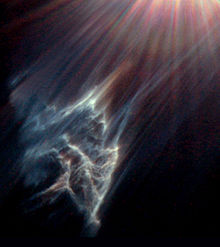Reflection nebula
In astronomy, reflection nebulae are clouds (nebulae) of interstellar dust that "reflect" the light of neighboring stars, but more precisely, scatter it.
Unlike emission nebulae, the stars in reflection nebulae are not hot enough to ionize the material, so they do not cause the nebula to glow on its own. Instead, the starlight is scattered by the microscopic nebula particles, which is what makes the nebula visible in the first place. The spectrum of the reflection nebula therefore resembles that of the incoming stars. Reflection nebulae usually appear blue because blue light is scattered more than red light; a similar effect provides the blue color of the sky.
Among the nebular particles are many carbon compounds (including diamond dust), but also those of other elements, especially iron and nickel. The latter often align themselves with the galactic magnetic field and thus cause a slight polarization of the scattered light (James B. Kaler, 1998).
About 500 reflection nebulae are known. Especially splendid are the bluish reflection nebulae around the stars of the Pleiades M 45. Also blue is the reflection nebula at the northern edge of the Trifid Nebula M 20. The red supergiant Antares is surrounded by the large red reflection nebula Ced 132.
The distinction between reflection and emission nebulae goes back to Edwin Hubble, who published the result of his investigations of astronomical nebulae (English bright nebulae) in 1922. The two types of nebulae are now sometimes called diffuse nebulae and can often be observed together. Part of Hubble's work is the Hubble luminosity law for reflection nebulae, which establishes a relationship between the apparent magnitude of 

where 

IC 349 (Barnard's Merope Nebula), a reflection nebula in the Pleiades
Questions and Answers
Q: What is a reflection nebula?
A: A reflection nebula is a cloud of dust that reflects the light of a star or many stars.
Q: What is emission nebula?
A: Emission nebula is a cloud of gas that is ionized and emits light of its own.
Q: Why can't the light from nearby stars ionize the gas of reflection nebulae?
A: The light from nearby stars is not hot enough to ionize the gas of the nebula to make an emission nebula.
Q: Why are reflection nebulae usually blue in color?
A: Reflection nebulae are usually blue in color because the scattering works better for blue light than red.
Q: Are reflection nebulae and emission nebulae often seen together?
A: Yes. Reflection nebulae and emission nebulae are usually seen together and sometimes are called 'diffuse nebulae'.
Q: Can reflection nebulae be the site of star formation?
A: Yes. Reflection nebulae may also be the site of star formation.
Q: What are some examples of reflection nebulae?
A: The Orion nebula is a good example of reflection nebulae.
Search within the encyclopedia
